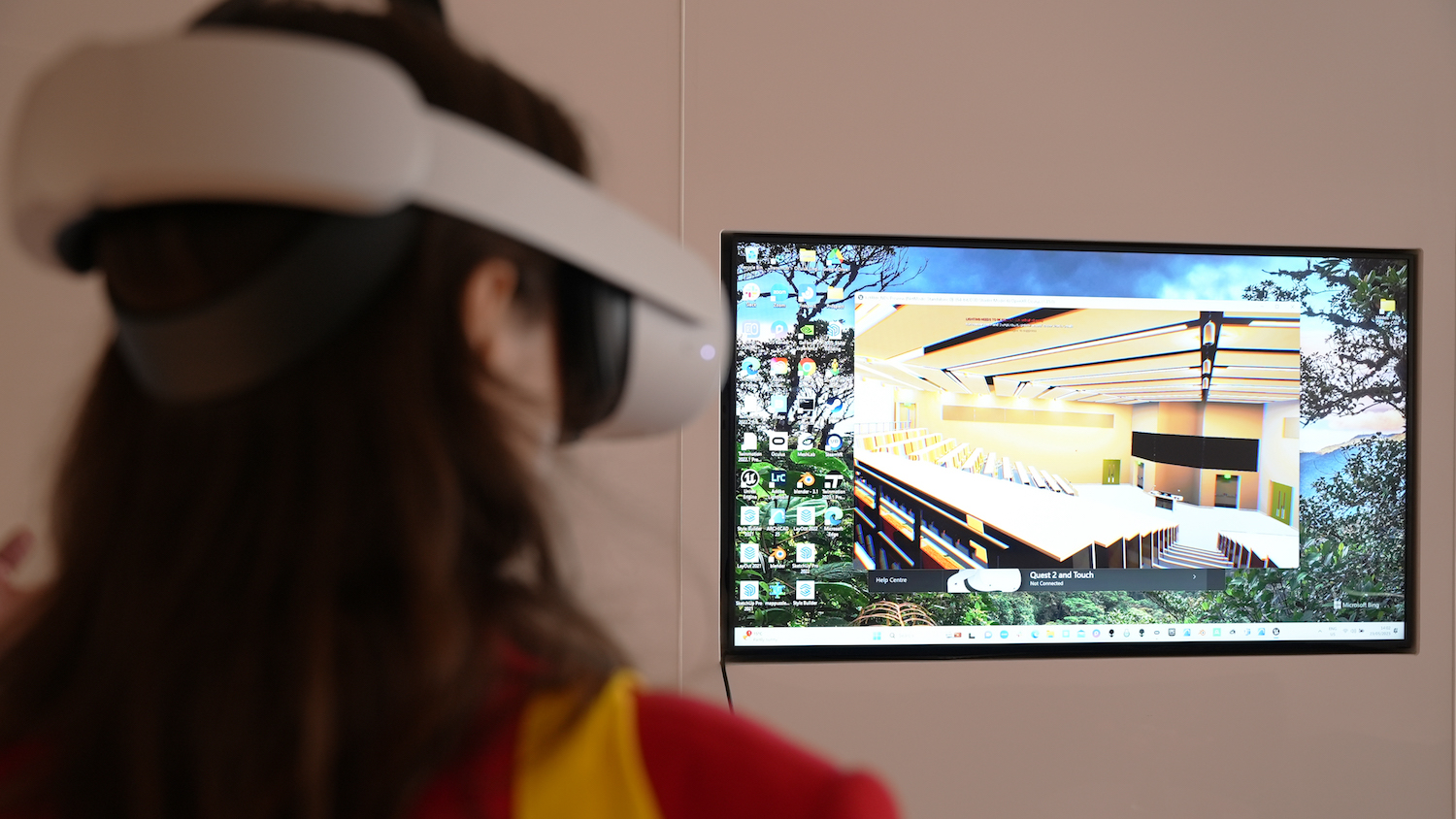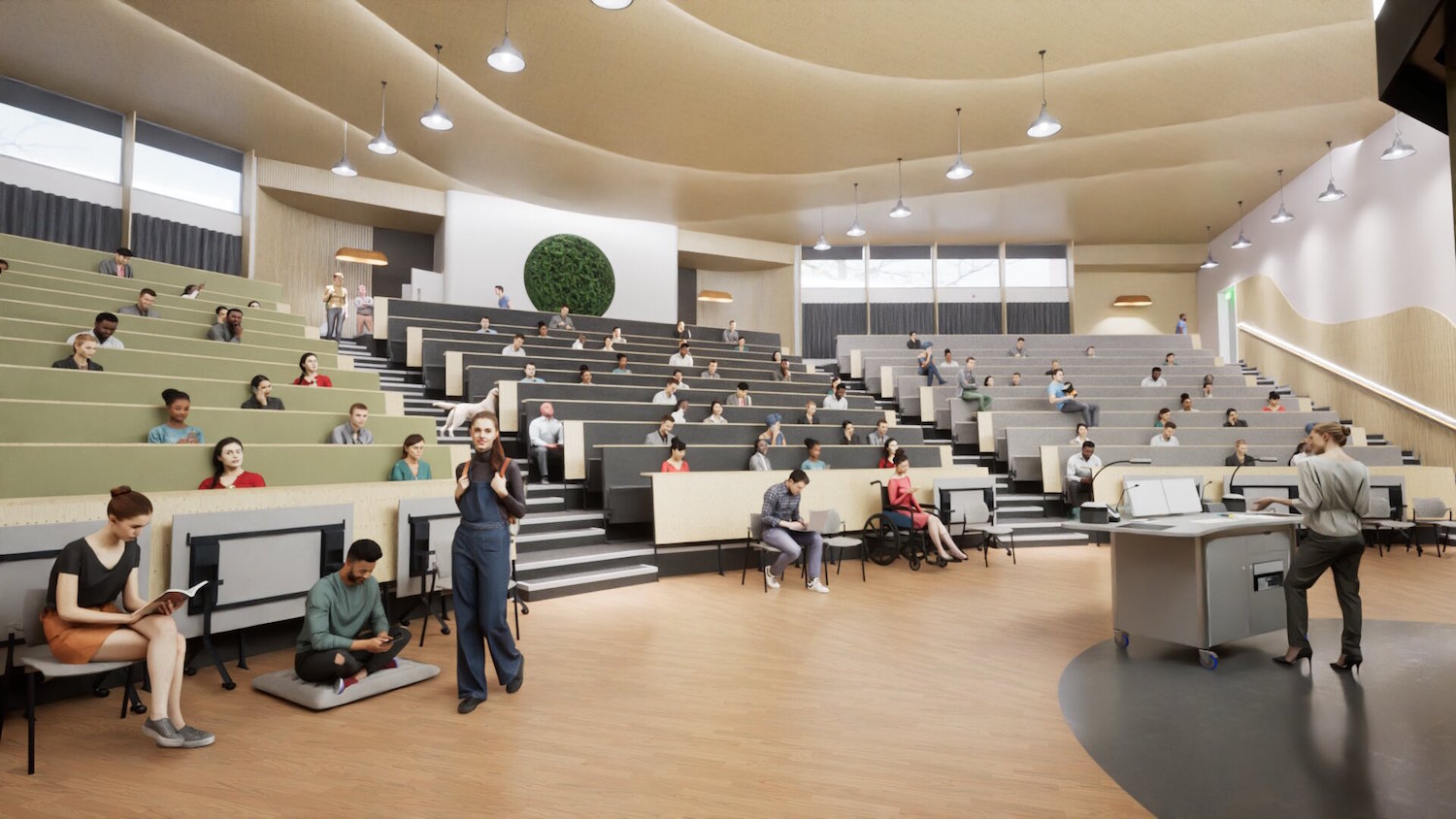
Maber Architects has been using VR and gaming software to help simulate the types of uncomfortable sensory experiences neurodivergent people and people with neurodegenerative conditions are exposed to in today’s buildings, in the hope that it will ultimately lead to more empathetic designs.
It is estimated that around one in seven people are neurodivergent and because of that, a significant number find elements of the built environment stressful or uncomfortable. This overstimulation, called ‘sensory overload’, can lead to increased anxiety, fatigue, and poor mental health in the workplace.
As more has become known about the impacts that different spaces, surfaces and colours may have on those with neurodivergent and neurodegenerative cognitive profiles, clients and their architects are beginning to consider adapting the design of buildings to make them friendlier environments for a neurodiverse population.
The University of Nottingham is one such organisation that wants its buildings to reflect greater neurodiversity and has recently commissioned Maber Architects to produce a design guide for neurodiversity and hidden disabilities. This has led to Maber simulating the impact of designs on people experiencing sensory overload in VR to help architects and clients understand the impact of their design choices.
As a collaboration between design disciplines including architecture, interior and digital, led by Josh Chrystal, and inclusive design, led by Stephanie Kyle, Maber looked to address how the university can approach design solutions for disabilities that are not covered within Part M of the Building Regulations. The design guide they produced covers various typologies – catering, residential, working spaces and learning spaces – in a graphic and interactive way.
Demonstrating before and after

“We try to empathise with end-users of our buildings to positively influence our design decisions. It’s very difficult to appreciate what someone with sensory processing differences is experiencing.”
The starting point, says Chrystal, was BIM models that demonstrate “before and after, good and bad design principles, based on examples of our previous work, and improving upon them”.
He explains: “We took a lecture theatre that we had previously designed to industry best practice for the time, and then looked at what we would change about the design with the knowledge we have now around helping people with hidden disabilities. Our initial outputs were static images produced using Archicad and Twinmotion to be incorporated within the design guide document, but we felt we could develop this further.”
Because they wanted to make the guidance more interactive, Chrystal says they went on to create a fully interactive VR experience, using real-time gaming software Unreal Engine 5 to simulate the experience that someone with a sensory processing difference might feel in a ‘typical’ lecture theatre environment.
“As designers, we try to empathise with end-users of our buildings to positively influence our design decisions. Although possible with some physical traits, it’s very difficult to appreciate what someone with sensory processing differences is experiencing. As an immersive experience with full-scale audio and visual stimulus, the VR environment is a really powerful tool for simulating what someone else might be experiencing.”
Excess visual stimulation
One example of how they did this in the VR headset was by changing the lighting to make it bright and brash with exaggerated contrasts in the room. “Sometimes, if there are reflections in the room from shuttering or solar shades over windows where the sun is coming through, it creates patterns on the floor, that can create excess visual stimulation, which becomes more intense to people with sensory processing differences. The idea of simulating these experiences was to allow neurotypical designers to get a sense of just how hostile environments can be for neurodivergent people and people with neurodegenerative conditions.”
Chrystal says Maber then went on to present the work with flooring manufacturer and wall cladding supplier Altro during Clerkenwell Design Week in May. “There was a good synergy between the thought leadership pieces that Altro and Maber were delivering around neurodiversity in the built environment. Their Clerkenwell event gave us a great platform to present our work and gather feedback from the hundreds of people who attended.”

Uncomfortable reality
Chrystal says there are so many neurodivergent and neurodegenerative conditions that simulating them all can be difficult. “One of the challenges we had was making sure that the simulation wasn’t too uncomfortable, because we wanted people to be able to put the headset on and experience it. But, obviously, the reality is that people who are living with these conditions are uncomfortable. So there was a fine line to tread.
“In terms of technical challenges, we were pushing the limits. You have people using VR for gaming, and you have people who are using VR for architectural design. And ours was kind of somewhere in between the two. So there was an element of learning from both types of applications, and pulling all that knowledge together to create a powerful architectural visualisation experience.”
Alongside Unreal Engine, Maber used an Oculus Quest 2 headset and a powerful laptop to produce the VR simulations, which Chrystal acknowledges represents a significant financial investment. However, he points out that there has been huge advancement in the past five or six years that makes the technology more accessible.
“The practice has been using VR from about 2017 and the technology has developed greatly in that time. We used to have to carry tripods with sensors and a heavy PC and it was a whole day trying to get it set up and calibrated.
“Now, though, a lot of the processing happens in the headset and with inside-out tracking, you don’t need external sensors. Set-up has become a seamless five-minute process of opening the laptop, scanning the environment with the headset and away you go. This plug-and-play functionality starts to unleash the potential of VR that was previously holding back its widespread adoption.”
Powerful visualisation
Chrystal says that in the construction industry there is sometimes a reluctance for people to put on VR headsets, yet, “it’s the most powerful, immersive experience for architectural visualisation. It gives people a sense of scale, materials and lighting that you cannot get in any other medium. It’s also an effective way of getting feedback from stakeholder groups with lived experience of disability, who may not be familiar with interpreting architectural drawing.”
Beyond being a visual experience, the VR simulation Maber has created allows users to pick up and interact with objects, open doors and other physics-based simulations. This level of interactivity further builds a sense of immersion that helps empower designers and decision-makers with tools to make the right choices when it comes to neurodiverse design.
On top of that, the VR experience also allows users to experience hyperacusis (hypersensitivity to acoustic stimulation) and hypersensitivity to interoception sounds (internal body sounds). “So as you are walking around, you’re hearing your footsteps, which can be quite loud and reverberating and stressful for those with a sensory processing difference,” he says. Although the practice had worked with Unreal Engine before, the sound and lighting effects were completely new territory.
“One of the challenges we had was making sure that the simulation wasn’t too uncomfortable. But the reality is that people who are living with these conditions are uncomfortable.”
Beware white desks
Chrystal says these experiences simulated by the VR were highlighted in a survey carried out by the University of Nottingham of its neurodivergent students. “So for example, 90% of lecture theatres have white plastic tables and worktops, and these are highly reflective, creating extra processing demand for people who process visual stimulation differently. One of the key takeaways for users of our VR simulator is that if these are changed to textured or matte finish worktops in a different colour, that would really help people as the light is not able to bounce as easily.”
He acknowledges that not everyone will have access to a VR headset. To get around this, Maber has also used Archicad and Unreal Engine to produce other media, such as a video fly-through of how someone with a sensory processing difference would experience coming into a building, trying to find their seat and leaving.
“The video and the guidance have been rolled out to the University of Nottingham estates team, so we have an appreciation of these issues when we commission new buildings and routine refurbishments. We are also using the video as part of our EDI training platform for all estates staff, so we all have a better understanding of how the built environment has an effect on staff, students and visitors. We can do this thanks to the visual clarity of the techniques used by Maber,” says Brendan Sexton, capital projects manager at the University of Nottingham.
Toolkit for neurodiversity
As a practice, Maber tries to appraise the designs of projects through this more inclusive lens. In time, it would like to create a design toolkit for inclusive design for any practice to use, in the same way others have produced sustainability toolkits. Chrystal points out that guidance in this area is very limited – although there is a newly published British Standard, BSI PAS 6493 Design for the Mind – Neurodiversity and the Built Environment.
“The PAS is detailed, but in some places lacks ways to apply the guidance to the design of buildings. Our guidance builds upon this and shows how you can achieve the points made in the PAS through design.
“We intend to produce a design guide to form part of our internal processes and ultimately aim to make the built environment a better place for people with hidden disabilities. By combining our technical expertise with engaging and interactive digital design guidance, we hope to empower everyone involved in the design process to make informed decisions around neurodiverse design solutions,” Chrystal concludes.
Don’t miss out on BIM and digital construction news: sign up to receive the BIMplus newsletter.












